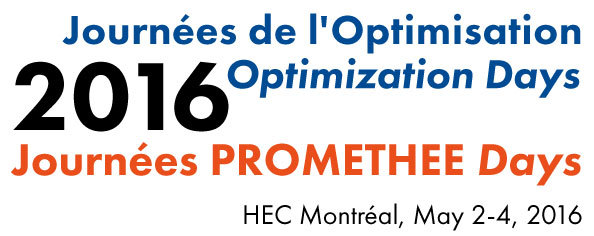
2016 Optimization Days
HEC Montréal, Québec, Canada, 2 — 4 May 2016

WA7 Conic and Polynomial Optimization
May 4, 2016 10:30 AM – 12:10 PM
Location: TAL Gestion globale d'actifs inc.
Chaired by Miguel F. Anjos
3 Presentations
-
 10:30 AM - 10:55 AM
10:30 AM - 10:55 AMComputational study of some valid inequalities to k-Way graph partitioning
We focus on identifying the strongest inequalities to tight the semidefinite programming (SDP) relaxation of the maximum k-cut problem. Therefore, we conduct an experimental study for four inequalities: Clique, General clique, Wheel and Bicycle wheel. Our tests suggest that the bicycle wheel and wheel are the strongest.
-
 10:55 AM - 11:20 AM
10:55 AM - 11:20 AMSemidefinite programming based approaches for quadratic programs with linear complementarity constraints
We present a semidefinite programming (SDP) relaxation for quadratic programs with linear complementarity constraints (QPLCC). We extract from the SDP solution a candidate point that can be used to warmstart an NLP solve of the QPLCC. We report computational results regarding the SDP bound, candidate point, and warmstarting procedures.
-
 11:20 AM - 11:45 AM
11:20 AM - 11:45 AMConvergence analysis for Lasserre’s hierarchy of upper bounds for polynomial optimization
We consider the problem of minimizing a polynomial over a compact set, and analyze a measure-based hierarchy of upper bounds proposed by Lasserre. This hierarchy is obtained by searching for an optimal probability density function which is a sum of squares of polynomials, so that the expectation is minimized. In this talk, we will show its rate of convergence. The main idea is to use the truncated Taylor series of the Gaussian distribution function.
